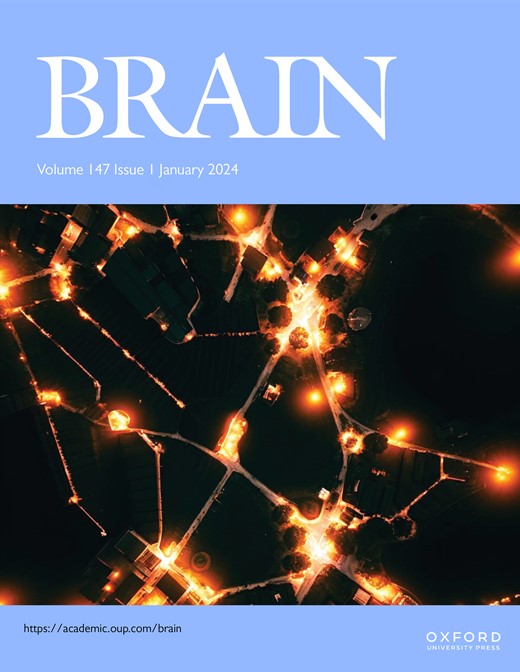改善Core 1和Core 2阿尔茨海默病CSF和血浆生物标志物的参考蛋白。
IF 11.7
1区 医学
Q1 CLINICAL NEUROLOGY
引用次数: 0
摘要
基于浓度的液体生物标志物代表了一种信息丰富且具有成本效益的检测和监测阿尔茨海默病(AD)病理的方法。然而,生物体液中与ad无关的个体间差异也会影响生物标志物的浓度。在这里,我们研究了脑脊液(CSF)和血浆生物标志物(如淀粉样蛋白-β40 (Aβ40)和非磷酸化的中部tau (np-tau))的标准化是否提高了它们代表AD病理负荷的稳健性和可靠性。使用瑞典BioFINDER-2队列(n=1702, 50.7%男性,平均[SD]年龄68.4[12.2]岁),我们在单变量线性回归模型中比较了tau/ a β- pet负荷与液体生物标志物单独与参考蛋白(a β40或np-tau)的比例之间的关系。液体生物标志物包括脑脊液和血浆中p-tau217、p-tau181、p-tau205、np-tau181-190、np-tau195-210、np-tau212-221、a - β42、a - β40和脑脊液MTBR-tau243、SNAP-25、神经颗粒蛋白、YKL-40、sTREM2和血浆eMTBR-tau243。采用质谱法和/或免疫分析法测定生物标志物。此外,我们进行了验证和扩展分析,比较了三个独立的前瞻性队列:BioFINDER-1、Knight阿尔茨海默病研究中心(ADRC)、衰老和痴呆转化生物标志物(TRIAD)以及意大利多发性硬化症队列,例如组水平的诊断差异和纵向生物标志物轨迹。脑脊液Aβ40正常化显著增强了几种核心脑脊液AD生物标志物,包括脑脊液MTBR-tau243、p-tau亚型和突触生物标志物与tau-PET (ΔR²=0.064-0.24)和Aβ-PET (ΔR²= 0.016-0.28)的相关性。脑脊液np-tau归一化主要改善了与Aβ-PET的一致性(ΔR²= -0.0059-0.19)。MTBR-tau243/ a - β40与tau-PET的相关性最强(R²= 0.78,非标准化MTBR-tau243的相关性为0.65),p-tau217/np-tau与a - β- pet的相关性最强(R²= 0.65,非标准化p-tau217的相关性为0.46)。血浆生物标志物与tau-PET的相关性在血浆Aβ40或np-tau归一化时得到改善(ΔR²= 0.004-0.14),其中eMTBR-tau243/np-tau的效果最强(R²= 0.72对0.60)。np-tau归一化增强了与Aβ-PET的相关性(ΔR²= 0.018-0.16,p-tau217/np-tau最强:R²= 0.62对0.53)。结果在Knight ADRC和TRIAD中得到了重复。此外,纵向分析表明,随着时间的推移,Aβ40正常化通常会降低个体间而不是个体内的变异性。正常化并没有增加AD患者炎症性脑脊液生物标志物的组水平差异,也没有改善多发性硬化症队列中生物标志物的相关性。综上所述,将脑脊液和血浆生物标志物标准化为参考蛋白,如Aβ40或np-tau,增强了它们与脑tau和Aβ病理的关联,使已经高性能的AD液体生物标志物更加准确。本文章由计算机程序翻译,如有差异,请以英文原文为准。
Reference proteins to improve Core 1 and Core 2 Alzheimer's disease CSF and plasma biomarkers.
Concentration-based fluid biomarkers represent an informative and cost-effective way to detect and monitor Alzheimer's disease (AD) pathology. However, non-AD-related inter-individual variation in biofluids can also affect biomarker concentrations. Here, we investigated whether normalization of cerebrospinal fluid (CSF) and plasma biomarkers to reference proteins, such as amyloid-β40 (Aβ40) and non-phosphorylated mid-region tau (np-tau), improves their robustness and reliability of representing AD pathology load. Using the Swedish BioFINDER-2 cohort (n=1702, 50.7% male, mean [SD] age 68.4 [12.2] years), we compared the associations between tau/Aβ-PET load and fluid biomarkers alone versus in a ratio with a reference protein (Aβ40 or np-tau) in univariate linear regression models. Fluid biomarkers included CSF and plasma measures of p-tau217, p-tau181, p-tau205, np-tau181-190, np-tau195-210, np-tau212-221, Aβ42, Aβ40, and CSF MTBR-tau243, SNAP-25, neurogranin, YKL-40, sTREM2, and plasma eMTBR-tau243. Biomarkers were measured with mass spectrometry assays and/or immunoassays. In addition, we performed validation and extended analyses, comparing for example group-level diagnostic differences and longitudinal biomarker trajectories, in three independent prospective cohorts: BioFINDER-1, Knight Alzheimer Disease Research Center (ADRC), and Translational Biomarkers in Aging and Dementia (TRIAD), as well as in an Italian multiple sclerosis cohort. CSF Aβ40 normalization significantly strengthened the associations of several core CSF AD biomarkers, including CSF MTBR-tau243, p-tau isoforms and synaptic biomarkers, with tau-PET (ΔR²=0.064-0.24) and Aβ-PET (ΔR² = 0.016-0.28). Normalization to CSF np-tau mainly improved concordance with Aβ-PET (ΔR² = -0.0059-0.19). The strongest association with tau-PET was observed for MTBR-tau243/Aβ40 (R² = 0.78, compared to 0.65 for non-normalized MTBR-tau243), and with Aβ-PET for p-tau217/np-tau (R² = 0.65, compared to 0.46 for non-normalized p-tau217). Plasma biomarker associations with tau-PET improved when using normalization to plasma Aβ40 or np-tau (ΔR² = 0.004-0.14), with the strongest effect for eMTBR-tau243/np-tau (R² = 0.72 versus 0.60). Associations with Aβ-PET were enhanced with np-tau normalization (ΔR² = 0.018-0.16, strongest for p-tau217/np-tau: R² = 0.62 versus 0.53). The results were replicated in Knight ADRC and TRIAD. Furthermore, longitudinal analyses showed that Aβ40 normalization typically reduced inter-individual rather than intra-individual variability over time. Normalization did not enhance group-level differences in inflammatory CSF biomarkers in AD, nor did it improve biomarker associations in the multiple sclerosis cohort. In conclusion, normalization of CSF and plasma biomarkers to reference proteins, such as Aβ40 or np-tau, enhances their association with brain tau and Aβ pathology, making already high-performing AD fluid biomarkers even more accurate.
求助全文
通过发布文献求助,成功后即可免费获取论文全文。
去求助
来源期刊

Brain
医学-临床神经学
CiteScore
20.30
自引率
4.10%
发文量
458
审稿时长
3-6 weeks
期刊介绍:
Brain, a journal focused on clinical neurology and translational neuroscience, has been publishing landmark papers since 1878. The journal aims to expand its scope by including studies that shed light on disease mechanisms and conducting innovative clinical trials for brain disorders. With a wide range of topics covered, the Editorial Board represents the international readership and diverse coverage of the journal. Accepted articles are promptly posted online, typically within a few weeks of acceptance. As of 2022, Brain holds an impressive impact factor of 14.5, according to the Journal Citation Reports.
 求助内容:
求助内容: 应助结果提醒方式:
应助结果提醒方式:


